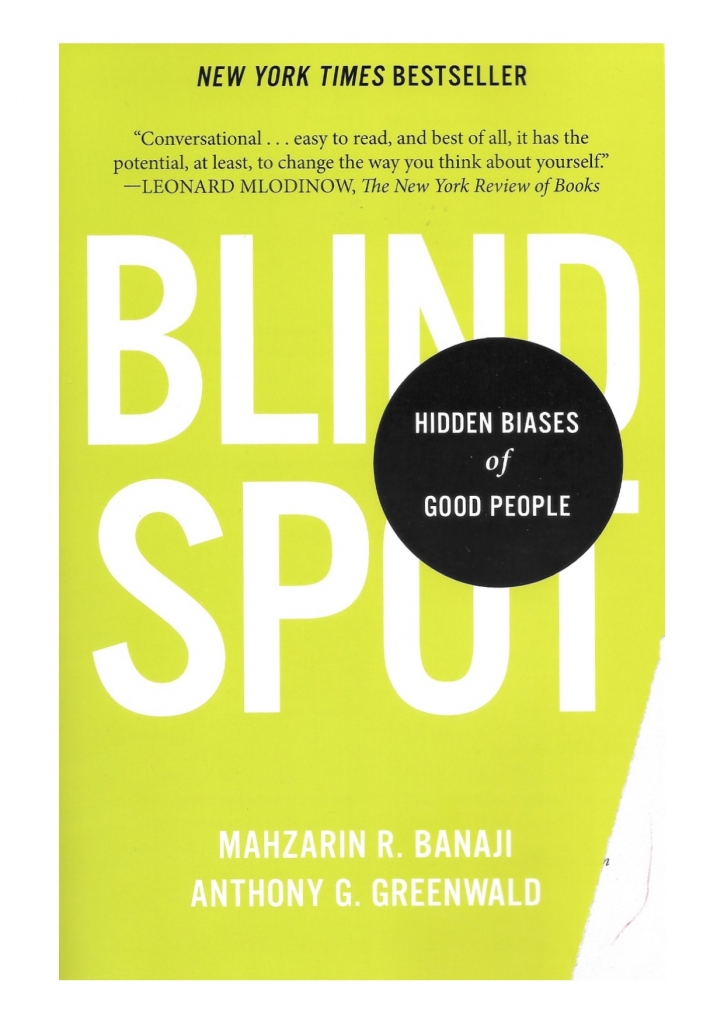The one sentence summary
Most right-minded people don’t even realise that they are biased.
WHAT THE BOOK SAYS

- This is written by two psychologists who explore the hidden biases we all carry from a lifetime of exposure to cultural attitudes about age, gender, race, ethnicity, religion, social class, disability status and nationality.
- They have invented the Implicit Association Test (IAT), a method that gives a glimpse of our unconscious biases at work. It has the subtitle ‘Hidden biases of good people’ because most right-minded people don’t even realise that they are biased. Explaining the science behind bias can enable those who intend well to align their behaviour with their intentions. Psychologists call these emotional values valence.
- The original IAT asks people to fill out two lists against the clock. The task is to mark insects and words pleasant in meaning in one group, and flowers and words pleasant in meaning in another. Everyone does the second one faster because they don’t have to go against associations the brain has already stored. Example at: bit.ly/T8h6uD.
- 14 million such tests had been completed by 2013.
- They then created the Race IAT, which asks you to group pleasant and unpleasant words with African American or European American children’s faces. The inventors shocked themselves by finding that subconsciously they could associate good things with white faces much faster (even with repeated taking of the test, they couldn’t shift their subconscious bias.) Over millions of tests, the Race IAT shows that 75% of Americans who take the test show automatic white preference. This is not the same as prejudice inasmuch as it is not openly hostile. However, of the 1.5m White Americans who have taken the Race IAT, 40% have explicit egalitarian beliefs accompanied by an automatic white preference.
- It is perfectly possible for black people to have white prejudice. Malcolm Gladwell, whose mother is Jamaican, was shocked to find he did.
- The gay v. straight IAT shows that it is also possible for a gay activist to have stronger gay = bad associations than gay = good.
- The young = good IAT shows that 80% of Americans have a young = good association, which leads to ageism.
- The Gender-Career IAT shows that 75% of men think male = work and female = family. The figure is 80% for women – another example of bias that can be self-defeating. There is also a gender blindspot here, because the test shows that both men and women would accept lower pay to work for a male boss, despite claiming no overt preference
- This can happen because of dissociation (the occurrence in the same mind of mutually inconsistent ideas that remain isolated from one another), and cognitive dissonance (becoming aware of conflicts between our beliefs and actions violates the natural human striving for mental harmony, or consonance). The membrane that divides the culture ‘out there’ from our mind ‘in here’ is permeable.
- The word stereotype entered the English language in the 1700s as the name for a printer’s metal plate that could hold an entire page of print. The human mind must think with the aid of categories, which become the basis for normal pre-judgement. Amazingly, stereotyping allows us to perceive strangers as distinctive individuals, so it can be a force for good empathy.
- We can easily handle 6 or 7 category variables when describing something. Taking 4 variables each for race, religion, age, nationality/region, sex/gender and occupation, we can generate 4 million of them. You can even stereotype yourself, leading to self-fulfilling or self-undermining prophecies.
POINTS TO CONSIDER AND DISCUSS
- General conclusions: black disadvantage definitely exists; this is at least partly to do with race discrimination; which is contributed to by implicit race attitudes (automatic race preference); social differentiation exists; attitudes have both reflective and automatic forms; people are often unaware of disagreement between the reflective and automatic forms of their own attitudes and stereotypes; explicit bias is infrequent, but implicit bias is pervasive.
- We all suffer from mindbugs, because the mind is an automatic association-making machine. So it is perfectly possible for us to read a list of insects and then claim that the word insect was on the list, when in fact it wasn’t. This effect is powerful enough to produce greater recollection of things that didn’t occur than of things that did occur.
- Retroactive interference is an influence of after-the-experience information on memory. For example, those asked ‘How fast was the car going when it smashed into the other car?’ give a far higher speed than those asked ‘…when it hit the other car?’
- There are many shades of truth and we all lie to some degree all the time. Consider your answers to questions like ‘How are you?’, ‘Do I look fat in these jeans?’, and ‘Can you spare a dollar?’
- Blue lies are based on impression management – answering questions to allow others to see us as we see ourselves. Examples include ‘Did you vote in the election?’ and ‘Did you do all the reading for the last test?
- Hidden biases can be reduced by some quite minimal interventions. For example, just taking a few minutes to imagine what a strong woman is like can significantly weaken the male = strong stereotype.
- All these ‘good people’ can be described as uncomfortable egalitarians. They have no awareness that they are doing anything discriminatory. They see themselves as helpful but their helpfulness is selective, which leads to collective favouritism in favour of people who are white, straight, male or young.
